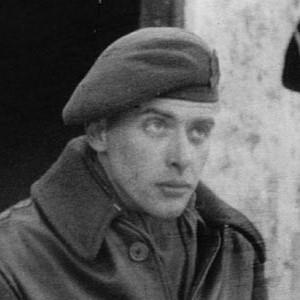


Alex Colville
David Alexander Colville, PC CC ONS LL. D. was a painter and printmaker who continues to achieve both popular and critical success.
Born in 1920 in Toronto, Ontario, Colville moved with his family at age seven to St. Catharines, and then to Amherst, Nova Scotia, in 1929. He attended Mount Allison University from 1938 to 1942, where he studied under Canadian Post-Impressionists like Stanley Royle and Sarah Hart, graduating with a Bachelor of Fine Arts.
Colville married Rhoda Wright, who he had been friends with since his first year at "Mount A," in 1942 and enlisted in the Canadian Army shortly afterwards. He enlisted in the infantry, eventually earning the rank of lieutenant. He painted in Yorkshire and took part in the Royal Canadian Navy's landings in southern France. He was then attached to the 3rd Canadian Division. After being in the army for two years, and because he was a fine-arts student, he was made a war artist in May 1944. His unit relieved the 82nd Airborne Division at Nijmegen, Netherlands in mid-September 1944 during Operation Market Garden and remained there until the following February. He continued on to tours in the Netherlands and Germany, where he was also tasked with depicting the horrors of the Bergen-Belsen concentration camp. Colville's painting Bodies in a Grave (1946), a scene of emaciated corpses in a Bergen-Belsen burial pit, is based on images he captured with his army-issue camera at the concentration camp.
Colville had some success while still enrolled at Mount Allison, exhibiting at the Art Association of Montreal (now the Montreal Museum of Fine Arts) in 1941, and the Royal Canadian Academy of Arts in 1942. After the war, Colville returned to New Brunswick and became a faculty member with the Fine Arts Department at Mount Allison University, where he taught from 1946 to 1963. Colville is often cited as belonging to the Magic Realism movement, and within this he developed his own style that influenced both a regional and national art community, as teacher and founder of what would become known as Maritime Realism. By contrast to other members of the Maritime school, the composition of his work involved geometry. Often too, in his later work, he seized on the fugitive moment, imagining a hypothetical "What if" something happened in the conscious world.
Maritime Realism came to fruition during the apex of abstract painting's ascendancy both nationally and internationally. Colville influenced a host of students that pursued a realist painting style. Norman Eastman (class of 1952), Hugh Mackenzie (class of 1953), Tom Forrestall (class of 1958), Christopher Pratt (class of 1961) Mary Pratt (class of 1961), Daniel Brown (class of 1961), Nancy Stevens (class of 1962), Ken Tomlie (class of 1962), Roger Savage (class of 1963), Suzanne Hill (class of 1964), Glenn Adams (class of 1965), and Don Pentz (class of 1966).
He left teaching to devote himself to painting and print-making full-time from a studio in his home on York Street; this building is now named Colville House.
Colville often used his immediate surroundings as subject matter, using his family as models. Throughout his career, his wife Rhoda Colville, who was also an artist and poet, served as a model for a number of his celebrated works. Rhoda Colville's recreational life as a swimmer, skater, dancer, singer, pianist and cyclist was featured in her husband's pieces, often set in the landscapes and waterways of Annapolis Valley.
In 1966, works by Colville along with those of Yves Gaucher and Sorel Etrog represented Canada at the Venice Biennale. In 1967, Colville was made an Officer of the Order of Canada, elevated to Companion in 1982, the order's highest level. In 1973, the University of Windsor gave him an honorary doctor of laws.
Colville lived in St. Catharines, Ontario, for three years before moving to Nova Scotia. In 1973, he moved his family to his wife's hometown of Wolfville, where they lived and worked in the house that her father built and in which she was born. The Colvilles had three sons, a daughter, and eight grandchildren.
In contrast to many of his contemporaries, Colville aligned himself with the Progressive Conservative Party of Canada and was a card-carrying party member for many years. In 1981 he was appointed chancellor of Nova Scotia's Acadia University serving in that role until 1991.
Colville died on 16 July 2013 at his house in Wolfville at the age of 92 of a heart condition. His wife Rhoda Wright died on 29 December 2012. They are survived by three of their four children, Graham, Charles, and Ann. Their second son, John, died on 22 February 2012.
